A competitive race begets more competitive races. That is what happened in 2018 when Robert “Beto” O’Rourke lost the 2018 Senate race to Ted Cruz by under 3%. Democrats flipped two Congressional districts, two State Senate districts, 12 State Representative districts, and gave incumbent Republicans a scare in numerous others. Biden is presently polling competitively with Trump in Texas, and Democrats hope to go two-for-two on years with down-ballot pickups. Republicans believe their candidates can separate themselves from the Presidential topline and prevent a Democratic cascade across the former gerrymander. Texas voters are on track to beat their 2016 and 2018 turnout, 6.38 million people have already voted with 11 days to go compared to the final turnout of 8.97 million in 2016 and 8.37 million in 2018. Texas historically has one of the nations lowest turnout percentages, therefore a comparatively high-turnout election may lead to unexpected results. The first article in this series looked at the competitive seats in the Dallas-Fort Worth Metroplex, and the second examined four Austin-based districts. Today, the series concludes with three seats in the Houston area and the 23rd Congressional district in San Antonio and the Rio Grande.
TX-02 (Houston)
Incumbent: Dan Crenshaw, Republican
2016 Presidential Election: 52.4% Trump, 43.1% Clinton
2018 Senate Election: 50.2% Cruz, 49% O’Rourke
2018 Congressional Election: 52.8% Crenshaw (R), 45.6% Litton (D)
Bachelor’s degree or higher: 44.6%
Population Ethnicity: 46.5% White, 31.6% Hispanic, 11.5% African American, 8.2% Asian
Congressional Ratings: DDHQ – Safe R, Cook Political – Likely R, Sabato’s Crystal Ball – Likely R, FiveThirtyEight – Solid R

The fundamentals of Texas’s 2nd Congressional district confound a model built on data. Freshman Dan Crenshaw is one of the best Republican Congressional fundraisers in the country, raising $14.8 million before October. Crenshaw raised 90% of this total through individual donations, and 40% of it during the last three months. The navy SEAL veteran was thrust into the limelight when his appearance was criticized on Saturday Night Live before the 2018 midterms, and then subsequently went to the show to accept their apology. Crenshaw leveraged this moment to build a loyal following among Conservative activists, and today the Congressman is one of President Trump’s most vocal and visible Congressional allies. In two years Crenshaw has published a book, hosts a podcast, has over a million followers on Twitter, and spoke at the 2020 Republican National Convention. Republicans view Crenshaw as a rising star, and it makes sense that an incumbent with Crenshaw’s profile and acumen can raise millions of dollars per month.
Not all of Crenshaw’s millions are spent on his reelection, which deceives data-based models. A sizable portion of his warchest has been goes towards hosting fundraisers, sponsoring ads, and assisting other Republicans. Crenshaw is still outspending his challenger, former O’Rourke campaign advisor Sima Ladjevardian, just not by a margin of 5 to 1. The fundraising discrepancy is the only recent data point available in TX02 – no firms have released polls of the Houston Congressional district. Now, the question is whether Crenshaw can translate his national support network into reelection locally. O’Rourke barely lost TX-02 in 2018, and statewide polling points towards Biden matching or outperforming O’Rourke’s margin. Crenshaw’s notoriety may work to his disadvantage if Trump underperforms Cruz in TX-02 and few voters split their tickets, as in 2018. For now the incumbent has the advantage.
TX-07 (Houston)
Incumbent: Lizzie Pannill Fletcher, Democrat
2016 Presidential Election: 48.5% Clinton, 47.1% Trump
2018 Senate Election: 53.3% O’Rourke, 46% Cruz
2018 Congressional Election: 52.5% Fletcher (D), 47.5% Culberson (R)
Bachelor’s degree or higher: 50.3%
Population Ethnicity: 38.9% White, 30.3% Hispanic, 15.1% African American, 12.1% Asian
Congressional Ratings: DDHQ – Toss Up, Cook Political – Likely D, Sabato’s Crystal Ball – Likely D, FiveThirtyEight – Likely D
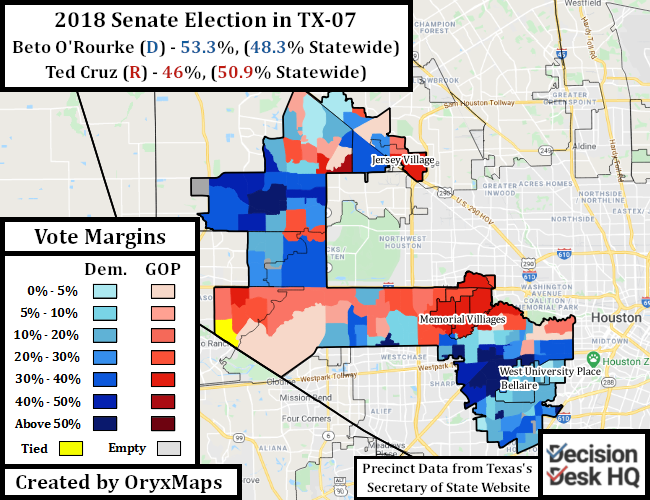
If the Republican nominee for Texas’s 7th Congressional district, Wesley Hunt, ran in a different political environment or in a different district, he would be the favorite to win the election. Hunt’s story as an African American West Point graduate and former helicopter pilot seems perfect for a district that is only plurality White. The veteran raised $5.9 million, $2.5 million of that total over the last three months, making him one of best funded GOP challengers in the country.
Unfortunately for Hunt, the deck is stacked against him. TX-07 was drawn as a Republican seat, yet Hillary Clinton carried the district in 2016. Beto O’Rourke expanded on Clinton’s coalition, and with Biden on track to match or outperform O’Rourke, TX-07 seems poised to once again vote Democratic at the top of the ticket. The only recent poll released is from Hunt’s own campaign, and Democratic Incumbent Lizzie Pannill Fletcher leads that poll by 2%. Hunt’s fundraising is impressive, yet Fletcher is keeping pace with him thanks to her extensive donor network from 2018. Fletcher raised $5.55 million before October, and has $1.6 million on hand compared to Hunt’s $1.35 million. Republican PACs and insiders have invested $4 million to unseat Fletcher, whereas Democratic groups previously spent $1.4 million to defend the incumbent. The Democratic House Majority PAC announced that they would spend $144K on ads during the last week of the campaign. The PAC planned a larger ad buy, but shifted funds to TX-22 citing Fletcher’s strong position.
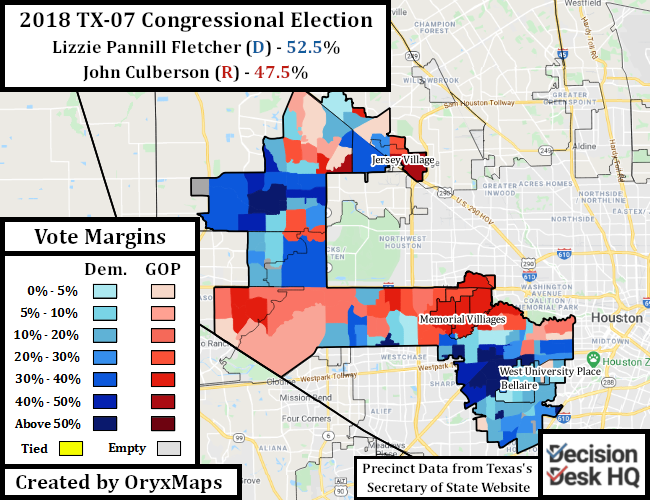
Although TX-07 is compact compared to other Lone Star districts, the seat remains a gerrymander designed to reelect Republican John Culberson. TX-07 was at one time the Congressional district of George H. W. Bush, but at that time the West Houston seat was designed by Democrats to pack in wealthy Republicans. The GOP took steps to spread out their vote after gaining control over the maps in 2003, and the most recent iteration drawn in 2010 took in more Democratic areas than previously.
There are roughly three parts to TX-07. The first part is the southeastern, the most Democratic part of the district. Anchored by Bellarie and West University Place, this wealthy region was transitioning in 2010 yet not Democratic enough considered blue. The second part of the district is the Northwest, a diverse and now Democratic region outside Houston proper. It was put in the district because, at the time, only one fourth of the residents voted. Those that did were White and Republican. Linking these two areas is a rectangular central strip containing most of uptown and West Houston. This region contains some of the most desirable properties in the city, is majority White, and strongly Republican due to TX-02 absorbing the Democratic parts closer to Houston’s city center. All three regions have swung towards the Democrats, but the center remains the most Republican of the three. Hunt has the money and the profile, but is unlikely to outrun demographic or partisan trends in any part of TX-07.
TX-22 (Southwest Houston Suburbs)
Incumbent: Pete Olson, Retiring, Republican
2016 Presidential Election: 52.1% Trump, 44.2% Clinton
2018 Senate Election: 50% Cruz, 49.3% O’Rourke
2018 Congressional Election: 51.4% Olson (R), 46.4% Kulkarni (D)
Bachelor’s degree or higher: 45.4%
Population Ethnicity: 37.8% White, 26.8% Hispanic, 14.1% African American, 18.1% Asian
Congressional Ratings: DDHQ – Lean D, Cook Political – Toss Up, Sabato’s Crystal Ball – Toss-Up, FiveThirtyEight – Lean R
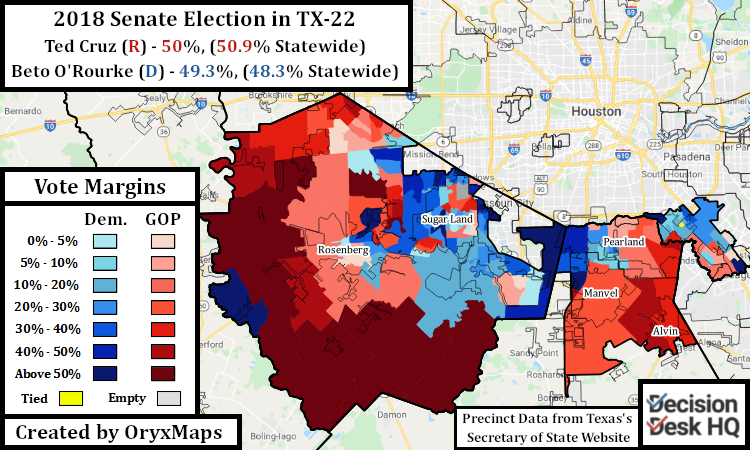
There are two Fort Bend stories on the ballot in Texas’s 22nd Congressional district, the seat representing the majority of the suburban county southwest of Houston. Republican nominee Troy Nehls’s story of army duty, law enforcement, and public service as Fort Bend County’s elected sheriff is a story that would be familiar to TX-22’s former Republican representatives. These include: Libertarian icon Ron Paul, Republican majority leader and Texas political boss Tom DeLay, and current Representative Pete Olson, a navy pilot and former staffer to John Cornyn. On the Democratic side of the ticket is Sri Preston Kulkarni, who represents the modern Fort Bend. Fort Bend voted Democratic in 2016 after explosive growth among college-educated young families and ethnic minorities in the Houston suburbs. Fort Bend County today is 31.9% White, 21.3% African American, 25% Hispanic, and 20.9% Asian. Kulkarni campaigns in 27 languages, a testament to both his experience in the foreign service and Fort Bend’s demographic transformation.
The Republican Party tried to cap Fort Bend’s demographic trends in 2010 by gerrymandering Mission Bend and Missouri City, the most African American and Democratic parts of the county, out of TX-22. In exchange the district gained the more conservative suburbs of Brazoria County to the East, and a handful of precincts in the outlying southeast corner of Houston. This gerrymandering and suburban growth created three near evenly divided political pieces. Fort Bend County accounted for about 68% of 2018 voters, and Cruz won the TX-22’s portion of the county by just 0.5% or 49.9% to 49.4%. Brazoria County accounted for 21% of the 2018 vote and Cruz won this portion by only 51.2% to 48.1%, as Democrats improved in Pearland and the precincts neighboring Missouri City. O’Rourke won the piece of Harris County 51.6% to 47.6%, but the county only contained 11% of 2018 TX-22 voters.
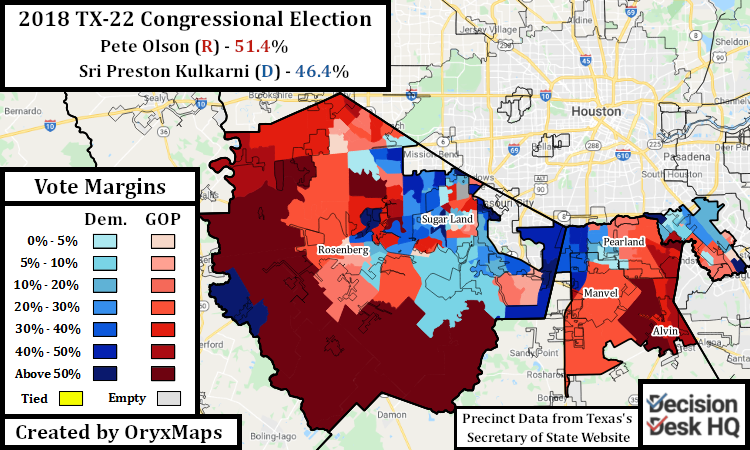
Kulkarni ran against retiring incumbent Pete Olson in 2018. Although he matched the incumbent in fundraising, ratings sites viewed his campaign skeptically. O’Rouke’s campaign helped the challenger by boosting turnout in the suburbs enough to bring the foreign service veteran within striking distance of the Republican incumbent. Kulkarni kept campaigning after 2018, and this time he laps the Republican in fundraising. Nehls raised $1.3 million over the course of this campaign and has only $360K on hand heading into October. Kulkarni raised $2.4 million before July and added an additional $2.1 million in the three months since. The GOP has stepped in to compensate for Nehls’s lack of fundraising; Republican groups have spent $4.7 million on the race for TX-22, and Democrats have spent $5.85 million. The Democratic House majority PAC is on the air with $704K in ads during the final week, and Everytown for Gun Safety is spending a portion of a $2 million ad buy in TX-22. The GOP reacted to these buys and invested $1.6 million on ads from now until election day.
Until last week there were only two polls of TX-22: a Republican internal with Nehls leading by 12%, and a lobbyist group poll which found the race tied. Over 20% of respondents in both polls were undecided. Last week though, Kulkarni released four months of internal polls. The late July internal found the candidates tied at 46%; the early August internal found Nehls leading 46% to 43%; the mid-August internal found Kulkarni leading by 1%; the late September internal found Kulkarni leading by 3%; and, the early October poll found Kulkarni leading 48% to Nehls 43%. Biden led in the October internal 52% to President Trump’s 43%. It is a positive trendline for Kulkarni, but the polls are internals. The demographics of TX-22’s active voter pool barely resemble the electorate which reelected Tom Delay, and the new electorate of TX-22 may be ready to vote for a new candidate who reflects the voters diversity.
TX-23 (Upper Rio Grande, Big Bend, El Paso outskirts, and San Antonio Suburbs)
Incumbent: Will Hurd, Retiring, Republican
2016 Presidential Election: 49.8% Clinton, 46.4% Trump
2018 Senate Election: 52.1% O’Rourke, 47.1% Cruz
2018 Congressional Election: 49.2% Hurd (R), 48.7% Ortiz Jones (D)
Bachelor’s degree or higher: 23.9%
Population Ethnicity: 23.9% White, 69.6% Hispanic, 2.9% African American, 1.9% Asian
Congressional Ratings: DDHQ – Lean D, Cook Political – Lean D, Sabato’s Crystal Ball – Leans D, FiveThirtyEight – Lean D

Texas’s 23rd Congressional district was supposed to be the only competitive district in Texas after the 2010 redistricting. The high concentration of Hispanic residents along the southern border requires Texas to draw a seat that gives Hispanic voters the opportunity to vote for their chosen candidate. Republican mappers carefully chose which areas to put into TX-23 so that the district would only have a slim majority of eligible Hispanic voters, despite the large number of Hispanic residents. A careful selection of precincts allowed Republicans to draw, and for several years control, a competitive seat in a Democratic part of the state. Republican incumbent Will Hurd won the district three times. Now, because of his retirement, TX-23 is the most likely Democratic pickup in the country, not including the districts affected by court-ordered redistricting in North Carolina.
There are two roughly equal parts of TX-23: Bexar (or San Antonio) County, and every other county in the district. Bexar is the whiter, suburban, and more Republican of the two halves. Republican mappers specifically chose safer Republican precincts to the north of San Antonio around Camp Bullis and heavily Hispanic precincts in the south of the County with few active voters. Democratic improvement among suburban voters has made this section of Bexar politically fluid, but it still marginally favors Republicans. Trump won the Bexar portion by a 2% margin, O’Rourke carried the piece by 3.5%, and Hurd won reelection in 2018 because of his 4.3% margin among Bexar voters. The rest of the district is polarized. Rural counties are red, Hispanic-majority counties are blue, and the deciding factor is turnout. Overall, the region favors Democrats, but turnout will decide exactly how wide that margin is.
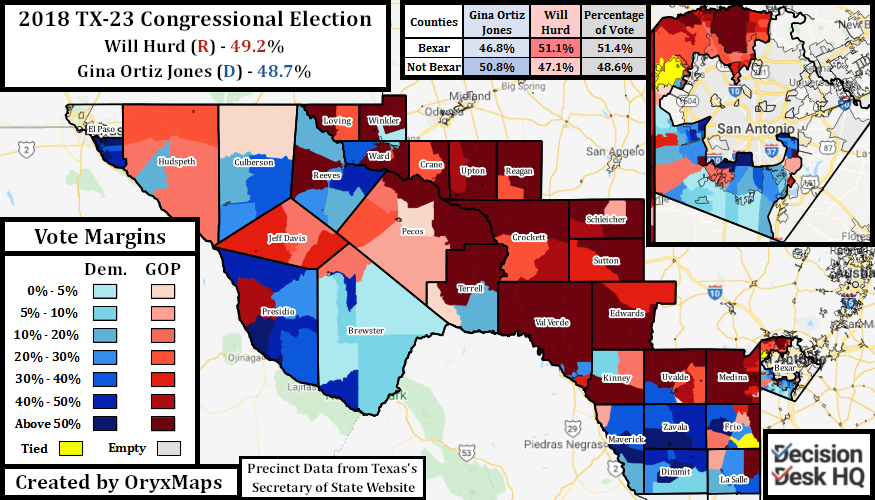
Gina Ortiz Jones never stopped campaigning after she won the Democratic primary in 2018. Polls that year suggested Hurd’s moderate brand would allow him to win reelection easily, but the race ended up decided by fewer than 1000 votes. Ortiz Jones, an Air Force veteran, is now the favorite, and she has raised over $5.7 million to flip TX-23 blue. Outside Democratic PACs have invested an additional $4 million in TX-23, including $829K from the House Majority PAC for the last week of October. Internal polls* from Republican, Tony Gonzales, have her ahead by slim margins. The toplines might disguise a larger lead for Ortiz Jones, because Hispanic voters are historically harder to poll and break in favor of Democrats in TX-23.
Gonzales isn’t doing himself any favors. The Republican Navy veteran emerged damaged from the Republican primary, which went to a July runoff that ended up decided by a scant, 7 vote recount margin in favor of Gonzales. Gonzales has raised only $2.1 million, and the contentious primary has left him with only $624K in the bank for the final month. Republican groups have already spent $3 million in TX-23, and the NRCC is spending another $944K on ads from now until election day. Gonzales has Hurd’s endorsement, but he and the incumbent are on opposite sides of the Republican party. Hurd won reelection through bipartisan appeals to Bexar County’s suburban voters, while Gonzales seeks to boost Republican turnout with Trump-style policies for the base. The problem for Gonzales is that TX-23 voted for Clinton, O’Rourke, and polling suggests it will vote for Biden. If Gonzales doesn’t give Biden voters a reason to split their tickets, then Gina Ortiz Jones will be the next representative for TX-23.
Ben Lefkowitz (@OryxMaps) is a Contributor to Decision Desk HQ.
*Correction: The source of this poll was originally misidentified.